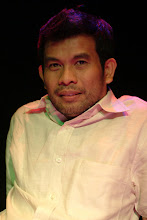
Awak dah tengok Budak Kelantan arahan Wan Azli?
Sinopsis Filem Budak Kelantan
Penerbit: Puad Onah
Pengarah: Wan Azli
Penulis: Wan Azli (Lakon layar)
Pelakon:
Danny (Buchek)
Bienda (Che Nor)
Mohd Asrulfaizal (Jaha)
Md Eyzendy Libokbong
Krew:
Pacai (Muzik)
Syarikat Penerbit : Grand Brilliance Sdn. Bhd.
Kategori : Filem Cereka
Bahasa : Bahasa Melayu
Genre : Drama
Klasifikasi : U - Untuk tontonan umum
Tarikh Tayangan : 30 Oktober 2008
Format : 35mm
Sinopsis Filem Budak Kelantan
Dua orang sahabat, Buchek dan Jaha bertemu kembali di Kuala Lumpur setelah terpisah sekian lama. Kini mereka sudah dewasa. Namun akibat menjalani hidup, sikap dan pandangan yang berbeza, dunia mereka tidak lagi sama.
Buchek baru sahaja menamatkan pengajian di UM manakala Jaha, yang pernah menjalani kehidupan di sekolah Henry Gurney, kini bergelumang di celah kesibukan Kotaraya Kuala Lumpur.
Di saat mereka bertemu, Jaha ingin berkongsi perjalanan kehidupannya dengan Buchek yang ternyata sangat berbeza dengan cara hidupnya. Buchek melihat cara kehidupan kawannya yang terlalu liar, lalu tercetus hasrat dihatinya untuk membantu Jaha ke jalan yang lurus.
Apabila Buchek mendapat tahu Jaha telah jatuh cinta pada Che Nor, teman wanitanya, Buchek rela melepaskan Che Nor, dengan harapan Jaha akan berubah. Buchek percaya cinta boleh mengubah kehidupan manusia.
Namun, Che Nor enggan memenuhi permintaan Buchek kerana hatinya hanya untuk Buchek. Dia kesal dengan tindakan Che Nor yang difikirkannya terlalu mementingkan diri sendiri lebih dari perintah Tuhan. Malangnya, Jaha maut dalam kemalangan sebelum sempat kembali ke pangkal jalan dan Buchek menyalahkan Che Nor kerana menolak cinta Jaha yang penuh keikhlasan. Dia mengambil keputusan meninggalkan Che Nor dan menyambut cinta Lee Chen Chen, gadis cina yang telah diselamatkan daripada menjadi mangsa nafsu Jaha dahulu.







6 comments:
Found your article very interesting. It is in line with the works and research of the late Nik Rashidi, of Kg. Tok Bali.
His efforts to trace the origins of Langkasuka through woodcarvings and embellishments is stimulating.
My research started after reading Stewart Wavell(1963) about the Naga King's Daughter, my interest in performance and tracing Hikayat Pattani. My talking to the late Nik Rashidin brought me to discussion about Langkasuka for "Spirit of Wood" but decided to pull myself from it due to some disagreement. My research continued to Laos, Cambodia, Indonesia, Vietnam, Myanmar and Funan and Majapahit artifacts in Guimmet Museum and Ecole Francais Extreme Orient in Paris.
Rarely came across articles such as yours in the internet concerning Langkasuka.
But still, thanks to the internet, because your research subject does not seem to be a very popular topic in the publishing world. If not for the internet, I doubt if I would ever come across articles such as yours.
Whatever you are doing, please continue and post in the website.
very impressive, any chance of being enlightened with the origins of the Malay? perhaps stashed somewhere in your research materials :) All and all, very enlightening read, good flow of text, wished for more findings. Looking forward for your future writeups.
regards
rozman
Very interesting and enlightning history of Langkasuka!
I must congratulate you for the interesting article. I rarely find article about Pre-Islamic Malay art forms on the internet, so thank you for the enlightenment.
But I disagree with your point that Javanese art forms prevailed on because the sultans lost their powers , but Malay art forms didn't have the same advantage because the sultans are still in power.
Note that some of the art forms you could find on Java was a product of Islamic era, when the sultans still in full power. Yet, Javanese art forms kept on developing.
Second, in the special province of Yogyakarta, the sultan has always the official power and position as the governor of the province, yet the province is well known as the art and cultural center of Indonesia.
So in conclusion, it has nothing to do with sultan being in power or not. The problem is with the difference between the Malay people and the Javanese people in observing Islamic values. The Javanese has no problem in syncretyzing old values and new values, while Malay tends to be more puritan in observing Islam.
That's why Javanese courts in Islamic era kept on creating new art forms, because even if they were Muslims, they don't mind their women wearing revealing costumes and perform in front of public (for an instance). While in Malaysia, even the relatively modest costumes of Mak Yong created a dislike with the puritan Muslims.
Oh, and please differentiate between the Malays and Javanese in respect of building monuments. The Javanese (along with the Balinese and others) has always been building monuments to show their devotion (and they don't like to be called "Malays" either). Even the Balinese still build monuments to this very day. Even the Sumatran Malays are different with the peninsular Malays, because they too, liked to build monuments to show their devotion (albeit more modest than the Javanese).
Thank you for the article and your attention.